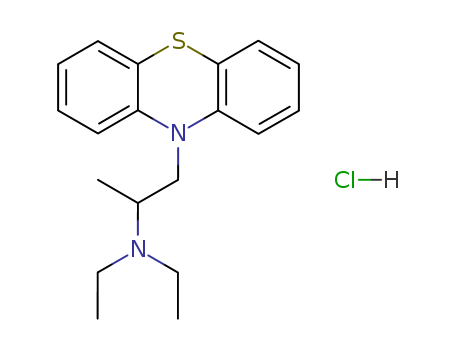- +86-0533-2185556
- +86 15965530500
- admin@hangyubiotech.com
Your Location:Home >Products >Pharmaceutical intermediate >1094-08-2


pd_meltingpoint:223-225° (some decompn)
Purity:99%
|
Manufacturing Process |
6.2 grams of phenthiazine in 100 cc of warm dry benzene was added during 1 hour with stirring, and in an atmosphere of hydrogen, to the Grignard reagent prepared from 1 gram of magnesium, 6.2 grams of methyl iodide, and 20 cc of dry ether. After boiling for 30 minutes, a solution of 6.6 grams of 2-chloro- 1-diethylamino propane in 10 cc of dry benzene was added during 1 hour to the boiling solution, and heating was maintained for a further 1.5 hours.The reaction mixture was then cooled and treated with aqueous ammonium chloride and chloroform added to dissolve an oil at the interface of the benzene and aqueous layers. The chloroform-benzene extract was extracted with 2 N hydrochloric acid and the acid extract was basified at 5° to 10°C with 50% aqueous sodium hydroxide.There was obtained a mixture of N-(2'-diethylamino-2'- methylethyl)phenthiazine and N-(2'-diethylamino-1'-methylethyl)phenthiazine in the form of a viscous yellow oil, BP 202° to 205°C/2 mm. This oil was treated in ethereal solution with ethereal hydrogen chloride and gave a white solid which was fractionally crystallized from ethylene dichloride. The less soluble fraction, N-(2'-diethylamino-2'-methylethyl)phenthiazine hydrochloride formed colorless rhombs, MP 223° to 225°C. The more soluble N-(2'- diethylamino-1'-methylethyl)phenthiazine hydrochloride was obtained as colorless prismatic needles, MP 166° to 168°C. |
|
Therapeutic Function |
Antiparkinsonian |
|
Biochem/physiol Actions |
Ethoproprazine hydrochloride is an inhibitor of butyrylcholinesterase; antiparkinsonian. It reduces extrapyramidal motor effects, characteristic of Parkinson′s disease; also alleviates thermal hyperalgesia in rats. |
|
Definition |
ChEBI: The monohydrochloride salt of profenamine. An antimuscarinic, it is used for the symptomatic treatment of Parkinson's disease. |
|
General Description |
Ethopropazinehydrochloride, 10-[2-(diethylamino)propyl]phenothiazinemonohydrochloride (Parsidol), introduced to therapy in1954, has antimuscarinic activity and is especially useful inthe symptomatic treatment of parkinsonism. In this capacity,it has value in controlling rigidity, and it also has a favorableeffect on tremor, sialorrhea, and oculogyric crises. |
InChI:InChI=1/C19H24N2S.ClH/c1-4-20(5-2)15(3)14-21-16-10-6-8-12-18(16)22-19-13-9-7-11-17(19)21;/h6-13,15H,4-5,14H2,1-3H3;1H

10-(2-diethylaminopropyl)phenothiazine
CAS:118685-33-9
CAS:66104-23-2
CAS:10196-49-3
CAS:6422-84-0